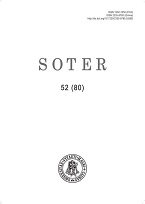Nukryžiuotojo Jėzaus ikonografija V–XVIII a. Vakarų Europoje
The iconography of crucified Jesus in 5th–18 th century western Europe
Author(s): Indrė ŠurkutėSubject(s): Christian Theology and Religion
Published by: Vytauto Didžiojo Universitetas
Keywords: Nukryžiuotasis; kryžius; ikonografija; vėlyvoji antika; ankstyvoji krikščioniškoji dailė; viduramžiai; Renesansas; Barokas Crucifixion; cross; iconography; Late Antiquity; Early Christian Art; middle ages; Renaissance, Baroque
Summary/Abstract: Straipsnyje nagrinėjama Nukryžiuotojo ikonografijos raida nuo seniausių išlikusių atvaizdų iki baroko pabaigos. Ant kryžiaus prikaltas Išganytojas dailės kūriniuose, priklausomai nuo paskirties, intencijų ir epochos stiliaus, krikščionių vaizduotas kaip Kunigas ir Karalius, didvyris ir nugalėtojas arba kaip apleistas, kenčiantis ir mirštantis Atpirkėjas, slegiamas viso pasaulio nuodėmių. Tikintysis šiuose atvaizduose gali įskaityti svarbiausias Bažnyčios doktrinos tiesas ir Senojo Testamento pranašysčių išsipildymą per Kristaus Kryžių. The Crucifixion iconography is constructed from various textual and visual sources of different ages. The most important were those which explained the fulfilment of the Scriptures. The rise of the Crucifixion iconography dates back to the beginning of the 3rd century. Although a small amount of the surviving examples contain certain differences, the pieces of art from 6 th –8 th centuries established and widely spread the iconographic canon. During the first millennium of the Christianity artists avoided displaying excessively realistic signs of death in the body of the crucified Christ. They rather emphasized the Saviour’s triumph over death and represented Him as Priest, King and Judge. Even in the tradition of Eastern Christians dead Christ on the cross looks as if He is calmly sleeping, but not suffering. Only in the 13 th century the image of the Crucifixion was overfilled with naturalistic signs of suffering. Such images invited believers to repent and unite their sufferings with those of the Redeemer. Although this tradition was continuing over the centuries, the Renaissance painters and sculptors found more interest in visualizing the divine beauty of the Son of God that death and suffering were not able to destroy. Baroque masters also enjoyed the idealized body of the Saviour, placing more emphasis on emotional suffering and the dramatic mood of the event. Moreover, in the images over the centuries the crucified Christ can appear in the midst of crowd of earthly, heavenly or even allegorical characters. Most common representations, however, include the Mother of God and John the Evangelist. No matter what type of iconographic composition is used, the image of the Crucifixion always encompasses most important Christian doctrines: the redemption of sins, the Eucharist mystery and the establishment of the Church.
Journal: SOTER: religijos mokslo žurnalas
- Issue Year: 80/2014
- Issue No: 52
- Page Range: 65-88
- Page Count: 24
- Language: Lithuanian

